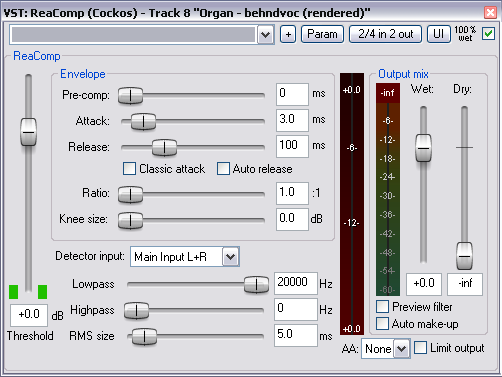Compression, or dynamic range compression is used to reduce the dynamic range (the difference between the quietest and loudest parts) of the signal.
It can be applied as an effect, so that the sound is obviously compressed or in subtle ways so that compression is applied in as transparent way as possible. There is no right or wrong way, just a matter of taste. Broadly speaking, the harder a sound is compressed the more obvious it becomes.
Compression in detail:
- Threshold – This is the level which sets where compression should start to be applied.
- Ratio – This is the amount of compression once the signal passes the threshold. For example a compression of 8:1 would mean that for every 8db of change past the threshold then only 1db will occur. At much higher such as 50:1, then in real terms no change will occur, hence the term limiting, as the user is limiting the level to a predetermined amount, set by the threshold. Although limiting will actually occur at much lower ratios. At very high ratios the term ‘brick wall limiting’ is often used to describe the effect, as if the sound has hit a virtual brick wall of compression.
- Attack – This is the time it take for compression to be applied once the signal passes the threshold.
- Release – This is the time it takes for the compression to stop once the sound drops below threshold.
- Knee – Often hard or soft, this determines the slope of the compression, in other words hard, like a straight edge, or soft for a more gentle slope.
- Make Up – When compression is applied it can then reduce the overall volume of the original signal. In this case, then make up gain is applied. Some units do this automatically.
There are no rules for the uses of compression, although in it commonly used for vocals, drums and bass, in most cases to smooth the sound out and reduce unevenness throughout the track.
Buss compression is often applied either at mix busses, such as entire drum sub-mixes or at the master section during the mix to again even out the sound.
In popular culture the term ‘loudness wars’ was coined to describe the over-use of compression in mixing and mastering. This was during a period, and in some cases still exists, where mastering engineers were forced by record companies to over-use compression, in order to try and make songs sound louder during radio play. In many cases mastering engineers were given the task of mastering tracks to get the highest possible volume from a track (often against their own professional judgement), otherwise record companies execs would often take their mastering work to engineers who would over compress.
Audio compression should not be confused with the compression used to reduce audio file sizes such as MP3 and WMA files.

